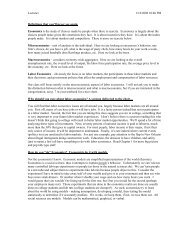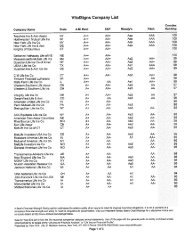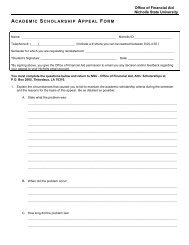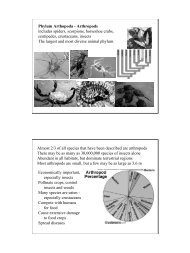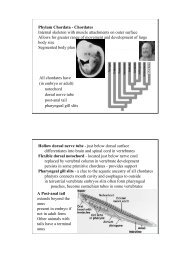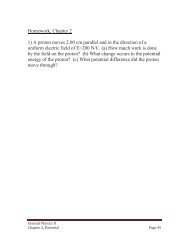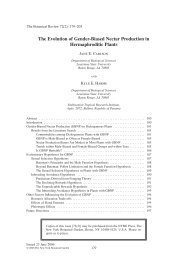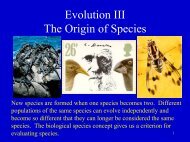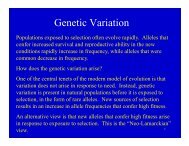Genetic Drift.pdf
Genetic Drift.pdf
Genetic Drift.pdf
- No tags were found...
You also want an ePaper? Increase the reach of your titles
YUMPU automatically turns print PDFs into web optimized ePapers that Google loves.
Alleles that do not affectfitness fluctuaterandomly in frequency.Random fluctuationeventually results in theloss of alleles (allelicextinction) frompopulations. One allelebecomes fixed – the onlyallele in the population.Sampling error (randomchance) results in somegene copies being lostand others continuing.i
Different populations will lose different alleles.The probability that a particular allele will be fixed in apopulation in the future equals the frequency of the allele in thepopulation. If there are two alleles in a population, A and a, withfrequencies p and q, the probability that the allele a will be lost atsome point in the future is p and the probability that allele A willbe lost is q.If a largenumber ofpopulations isconsidered,each hdifi drifting,the totalheterozygosityyoverall willdecrease.
Starting with a population sizeof N with two alleles in equalfrequencies p and q, the likelymagnitude of divergence fromthe initial frequencies increaseswith time.After 2N generations, allallele frequencies are equallylikely.The average time to fixationof one eof the alleles esis 4Ngenerations.
The effective population sizeis the number of individualsin the population thatsuccessfully pass genes tothe next generation. This isusually smaller than theactual number (censusnumber) in the population.The smaller the effectivepopulation size, the faster apopulation will drift, and thefaster one of the alleles l inthe population will becomefixed.
The effective populations size (N e ) is affected by biologicalparameters other than the number of individuals in the population.Variation in offspringnumber among individualsid can reduce N e . If someindividuals produce moreoffspring than others theiralleles, even those thathave no effect on fitness,will be passed on at higherrates.A sex ratio other than 1:1 produces a similar reduction in N eNatural selection at one gene can produce differences in offspringNatural selection at one gene can produce differences in offspringnumber among individuals and reduce N e
Inbreeding within or between generations reduces the number ofdifferent copies of a gene passed to the next generation andeffectively reduces N eFluctuations in population size reduce N e . Temporary decreasesin population size have greater effects than temporary increasesin population pp size.A temporary reduction inpopulation lti size is called lldabottleneck.
Read: A Strong Bottleneck Reduced the Heterozygosity of ElephantSeals
When a small number of fidiid individuals from a source population ltiestablish a new population genetic variation can be lost. The loss ofgenetic variation due to such an extreme bottleneck is called thefounder effect.Founder effects may make formerly rare alleles common.
Simulations of founder effectssuggest that a small numberfounders and a small populationgrowth rate (r) result in greater lossof genetic diversity.Eventually mutation will restoregenetic variation in a foundingpopulation.
Studies of laboratory and natural populations confirm thetheoretical expectations of genetic drift models.107 populations offruit flies each startedwith 16 heterozygotes,8 males and 8 females.8 d l h8 randomly chosenmales and femaleswere used to start eachgeneration.
<strong>Genetic</strong> <strong>Drift</strong> and Natural Selection• Directional selection will cause the frequency of alleles thatconfer high fitness to increase.• In small populations drift may increase or decrease allelefrequencies independent d of the fitness they confer.• Very strong selective regimes may make drift negligible• Very small population sizes may make the effects of drift solarge that selection is negligible.
Dobzhansky and Pavlovsky’sexperiment:• Used fruit flies with twodifferent inversions P and A.• Created heterozygotes forboth inversions – PA hybrids• They knew that PA hybridshad higher fitness thanhomozygotes• And, fitness of fAAhomozygotes was greaterthan PP homozygotes.• So, they expected the P alleleto decrease in culturesStarted 10 replicates ofpopulations with 20 flies – thehigh drift treatmentStarted 10 replicates ofpopulations with 4000 flies –the low drift treatment.
They found frequencies of the two types varied among culturesmuch more in the high drift treatmentBut, the average frequency of the P allele in the two treatmentswas nearly the same at the end of the experiment.
Kimura showed mathematically that selection is more importantif the selection coefficient i (s) is greater than 1/2N e.The probability offixation of a favoredallele due to naturalselection increaseswith increased fitnessadvantage and withincreased populationsize.
When techniques for analysis of molecular l variation i becameavailable (protein electrophoresis and then later gene sequencing)the amount of genetic variation within and between populations p wassurprising. It had been expected that there would be little variationwithin natural populations because natural selection would havecaused the fixation of high fitness alleles.The neutral theory of molecular evolution holds that althoughsome genetic variation is selectively advantageous ordisadvantageous and can result in natural selection, most geneticvariation is effectively neutral.The neutral theory predicts that most of the variation betweenpopulations or species is selectively neutral.
Alleles of a gene can be selectively neutral due to• synonymous codon changes• nonsynonymous changes that have little functional effect• changes in noncoding regions
The Molecular Clock - early in the history of the study ofmolecular l evolution it was hypothesized h that molecular l evolutionmay be different than morphological evolution. Molecularevolution may yproceed at a constant rate.If the molecular clock hypothesis is true, the time sincedivergence of two species could be estimated by the number ofDNA base pair differences between species.
The rate of molecularevolution can beestimated by referringto the fossil record.The fossil record givesan approximate dateof divergence ofgenetic lineages. Therate of molecularchange can then beestimated.Not all groups appearto evolve at the samerate.
Tests of the molecular clockIf evolution is clock-like then any two pairs of species shouldbe equally different from an outgroupThis is called the geneticequidistant principle or therelative rate test.
Studies of closely related species suggest that the rate ofmolecular l evolution is often nearly constant.Studies of moredistantly related speciessuggest that the rate ofmolecular evolution canvary greatly amonggroups. For example,within primates andwithin rodents the ratesof evolution have beenrelatively constant.However, primates haveevolved relativelyslowly compared torodents.
Why should there be molecular clock?Neutral genetic variation can be expected to evolve according to themathematical expectations of genetic drift modelsNeutral alleles l arise bymutation and many arelost but some increaseand become fixed.Over long periods oftime more alleleslbecome fixed.
Since there are 2*N e copies of a gene to mutate in a populationthe number of new alleles in a population pp in each generationshould be μ∗2*N eThe probability that a new neutral allele will eventually becomefixed is equal to its initial frequency, 1/(2*N e )So the number of new alleles that arise in each generation thatwill someday become fixed isμ*2*N e * 1/(2*N e ) = μThus the rate of fixation of neutral alleles is equal to themutation rate. This is the basis of the molecular clock.If we have 2 species that have diverged from a common ancestort generations ago and have D mutational differences betweenthem, the rate of production o of neutral mutations can beestimated as μ = D/2t
Over long periods of timethis estimate becomespoorer because ofmultiple mutations at thesame site or “multiplehits” or “mutationalsaturation. ”




